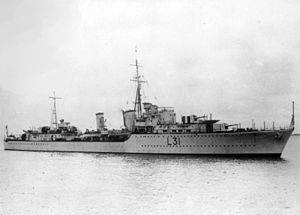 Mohawk
| |
| History | |
|---|---|
| Name | Mohawk |
| Namesake | Mohawk people |
| Ordered | 10 March 1936 |
| Builder | Thornycroft, Woolston, Southampton |
| Cost | £339,585 |
| Laid down | 16 July 1936 |
| Launched | 5 October 1937 |
| Completed | 7 September 1938 |
| Commissioned | 9 September 1938 |
| Identification | Pennant numbers: L31/F31/G31 |
| Fate | Sunk by Italian destroyer Luca Tarigo, 16 April 1941 |
| General characteristics (as built) | |
| Class and type | Tribal-class destroyer |
| Displacement | |
| Length | 377 ft (114.9 m) (o/a) |
| Beam | 36 ft 6 in (11.13 m) |
| Draught | 11 ft 3 in (3.43 m) |
| Installed power |
|
| Propulsion | 2 × shafts; 2 × geared steam turbines |
| Speed | 36 knots (67 km/h; 41 mph) |
| Range | 5,700 nmi (10,600 km; 6,600 mi) at 15 knots (28 km/h; 17 mph) |
| Complement | 190 |
| Sensors and processing systems | ASDIC |
| Armament |
|
HMS Mohawk was one of 16 Tribal-class destroyers built for the Royal Navy shortly before the beginning of Second World War in 1939. Completed in 1938 the ship was initially assigned to the Mediterranean Fleet. She was briefly involved enforcing the arms blockade on the combatants in the Spanish Civil War in early 1939. Mohawk returned home shortly after the start of the Second World War and was assigned convoy escort duties, during which she was damaged by German bombers. She played an active role in the Norwegian Campaign of April–May 1940, escorting convoys to and from Norway.
The ship was assigned to the 14th Destroyer Flotilla (DF) of the Mediterranean Fleet in June and began escorting convoys to Malta and Greece. Mohawk played a minor role in the Battle of Calabria in July and the Battle of Cape Matapan in March 1941. The following month the ship was sunk by torpedoes fired by an Italian destroyer off the Tunisian coast as the 14th DF attacked an Italian convoy, with the loss of 41 of her crew.